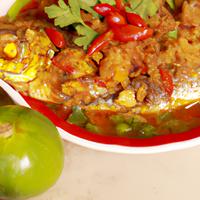
1 serving (100 grams) contains 150 calories, 25.0 grams of protein, 5.0 grams of fat, and 0.0 grams of carbohydrates.

Log this food in SnapCalorie

Nutrition Information
Calories |
357.1 | ||
|---|---|---|---|
% Daily Value* |
|||
| Total Fat | 11.9 g | 15% | |
| Saturated Fat | 3.6 g | 18% | |
| Polyunsaturated Fat | 0 g | ||
| Cholesterol | 166.7 mg | 55% | |
| Sodium | 1190.5 mg | 51% | |
| Total Carbohydrates | 0 g | 0% | |
| Dietary Fiber | 0 g | 0% | |
| Sugars | 0 g | ||
| protein | 59.5 g | 119% | |
| Vitamin D | 476.2 mcg | 2381% | |
| Calcium | 71.4 mg | 5% | |
| Iron | 2.4 mg | 13% | |
| Potassium | 714.3 mg | 15% | |
* Percent Daily Values are based on a 2,000 calorie diet. Your daily values may be higher or lower depending on your calorie needs.
Food Attributes
Source of Calories
About Pindang fish
Pindang fish is a traditional Indonesian dish, known for its flavorful preparation and rich nutritional profile. The fish, commonly mackerel or tuna, is typically boiled with salt and often marinated with a blend of spices such as turmeric, ginger, and lemongrass, giving it a distinctive taste and aroma. As a protein-rich food, Pindang fish provides essential amino acids that support muscle growth and repair, as well as omega-3 fatty acids, which promote heart and brain health. Its preparation minimizes the need for excessive oils, making it a relatively healthy choice in comparison to fried options. Additionally, the spices used are packed with antioxidants and anti-inflammatory properties. However, some variations may include high amounts of salt, which can be a concern for individuals with sodium sensitivity or hypertension. Originating from Indonesia, this dish is a delightful representation of Southeast Asian culinary traditions.



